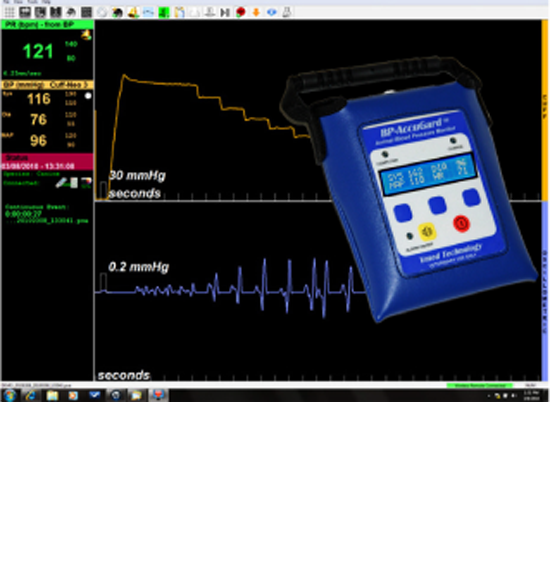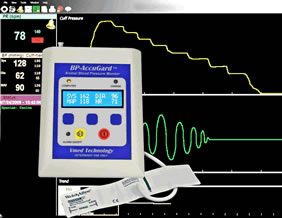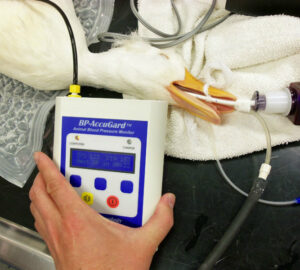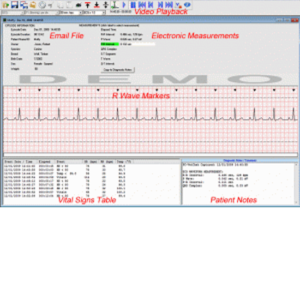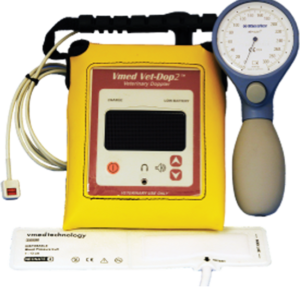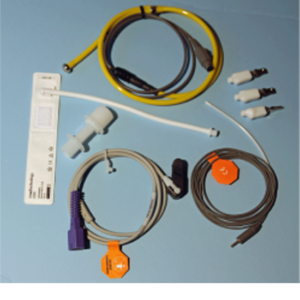bp-accugard
Oscillometric blood pressure monitor. Includes built-in display and optional Bluetooth computer link.
![]() AccuGard Flyer Access to literature requires the free Acrobat Reader (www.adobe.com)
AccuGard Flyer Access to literature requires the free Acrobat Reader (www.adobe.com)
Oscillometric Blood Pressure System
- Built-in, lighted display
- Optional Bluetooth wireless computer link
- Manual and automatic operation
Features
- Designed for veterinarians for manual and automatic calculation of systolic, diastolic, mean arterial pressures and heart rate in small animals
- Compatible with Windows XP (SP2 or higher) through Windows 10
- Easy setup and use
- Easy cuff size selection
- Programmable settings
- Selectable alarms with quick alarm silencing button
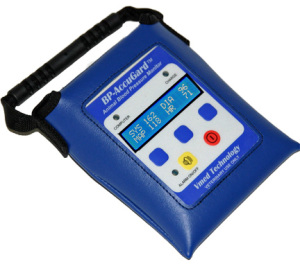
Includes protective pouch with handle and stand for viewing in surgery
- Automatic calculation of mean measurements
- Motion tolerant and small animal validated software
- Use with or without computer display
- Rechargeable lithium-ion battery with 18 hours between charges
- Two year parts and labor limited warranty
Standard Accessories
- Six cuffs with convenient limb circumference gauge for kittens to large breed dogs
- 8′ airline
- 100-240 VAC, 50/60 Hz charger
- Storage pouch
- Protective pouch
- Stand for surgical viewing
- Optional Bluetooth USB device
- Optional PC-Display software
Vmed uses SunTech Medical Advantage Vet Software which performed significantly better and with less variability than Cardell and Critikon Dinamap monitors on awake and anesthetized cats when compared to the Doppler reference in a controlled study at the North Carolina Stale University College of Veterinary Medicine . Performance on awake and anesthetized dogs was comparable for all three monitors.
BP-AccuGard is a digital oscillometric blood pressure monitor optimized for small animals. Oscillometric devices measure the oscillation of the vessel wall as the cuff is deflated. The BP- AccuGard uses sophisticated algorithms to calculate the blood pressure measurements from these oscillations based on the pressure in the cuff. While all oscillometric devices have limitations, especially with patient movement and the relatively small size of arteries in small animals, the BP-AccuGard software is successful in significantly reducing motion artifacts,
resulting in fast, accurate measurements. Accurate measurements have been obtained on patients as small as 1.5 kg under anesthesia. Includes manual and automatic modes for diagnostic and surgical applications. In manual mode the measurement cycle is started each time a measurement is desired. Automatic mode allows repeat measurements taken at user defined intervals. Motion tolerant software reduces the compute time for awake animals without compromising accuracy. BP-AccuGard offers superior, animal validated, motion tolerant technology for fast, accurate measurements in animals as small as 1.5 kg. Measure systolic, diastolic, MAP and heart rate and with a single key stroke, automatically calculate mean measurements over several readings for best accuracy. Use as a stand-alone blood pressure monitor or include the optional PC-Display software and Bluetooth wireless link to display measurements, real-time blood pressure waveforms and a trend graph on your computer screen. PC-Display software stores all measurements for the surgical or diagnostic record. When used in the automatic mode and in conjunction with the PC-Display software, measurements are saved to file for a record of pressures through the procedure. Files saved to the computer can be attached to patient records in most practice management programs. Reports can be printed from your computer or network printer or automatically attached to an E-mail message.
![]()
The optional Bluetooth hardware and PC-Display software provide a wireless connection between the AccuGard and your computer allowing the computer to function as a convenient patient monitor. The computer displays digital measurements as well as waveforms for the measurement cycle, pressure oscillations and a trend graph. Measurements appear simultaneously on the AccuGard. Bluetooth signals are omni directional and operate free of signal interference in the clinic. Range is reduced when transmission is through walls or between floors. Go Wireless…Go Digital with Vmed Bluetooth wireless monitors. Bluetooth is free of interference and is omni-directional to a range of 100 meters, line of sight. All controls except keyboard entry are at the patient’s side. Save space, eliminate cables and store files automatically. Establish a wireless link to your Windows desktop, laptop or tablet computer to display real-time patient monitoring waveforms and digital data on your computer screen. Monitor up to seven patients on one computer. Files may be recalled for review, transmitted by email or printed in a concise report. All hardware, software and monitoring accessories are provided with our monitors as described below. Compatible with Windows 8, 7, Vista and XP computers.
Vmed wireless monitors now Integrate with AVImark®. See these instructions.
Applications
- Use in manual mode to screen for hypertension in the exam room.
- Record BP routinely for patients where hypertension is secondary to disease and for all patients with visual problems and all critically ill patients.
- Use in automatic mode for surgery.
- Select specific measurement cycles and alarm limits for systolic, diastolic, MAP and heart rate. Alarms can be easily silenced by pressing the silence alarm button.
Blood Pressure in Veterinary Medicine (1)
“On a practical level, every veterinary practice should have a blood pressure unit, especially in feline medicine. Numerous studies in the veterinary literature show that a large percentage of cats more than 12 years of age have hypertension, either secondary to chronic renal disease or from underlying thyroid disease. A blood pressure monitoring device is critical for practitioners who see a large number of geriatric feline patients. Blood pressure should be recorded for cats with left ventricular hypertrophy of an unknown cause, cats with renal disease, cats with acute visual problems, and other critically ill patients. Diseases commonly associated with hypertension in both the dog and cat, include systemic hypertension and renal disease, hyperadrenocorticism, hyperthyroidism, essential of primary hypertension, and pheochromocytoma. Of these, Cushing’s disease, (dogs) and renal disease are probably the most common. The majority of cats diagnosed as hypertensive are presented to veterinarians for the evaluation of ocular abnormalities such as dilated pupils, hyphema or presumed blindness. It is important to realize that “normal” is going to depend on technique and the status of the patient. It is best to take 5 to 6 recordings and to eliminate the upper and lower values and average the remaining values. A systolic blood pressure is elevated in an unstressed, awake, dog or cat if it is consistently greater than 170-180 mmHg in the cat, or greater than 180 mmHg in the dog.”
(1) Systemic Hypertension: Diagnosis & Treatment, Larry P. Tilley, DVM, DACVIM (Internal Medicine)
Computer Requirements
Windows XP (Service Pack 2 or 3 highly recommended):
- CPU: Minimum 1GHz
- MEMORY: Minimum 1 GB (for 1-2 concurrent monitoring sessions)
- VIDEO: Minimum 64 MB Graphics Memory
- VIDEO RESOLUTION: Minimum 800×600 (1024×768 or higher recommended)
- PORTS: Spare USB 1.1 or higher (for Bluetooth USB Adapter, unless computer has built-in Bluetooth)
Windows 7, 8 and 10:
- CPU: Minimum 1 GHz
- MEMORY: Minimum 1.5 GB (for 1-2 concurrent monitoring sessions)
- VIDEO: Minimum 128 MB Graphics memory
- VIDEO RESOLUTION: Minimum 1024×768
- PORTS: Spare USB (for Bluetooth USB Adapter, unless computer has built-in Bluetooth)
Both 32-bit and 64-bit versions of Windows Vista, 7, 8.1 and 10 are acceptable.
Please read this if you have or are considering using a Microsoft Surface Pro tablet with your Vmed device.

